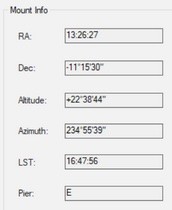ajobacho You say that +2 in Stellarium is the zone time, but it isn't, it is the TIME.
That "+2" value is actually called the "UTC Offset."
https://en.wikipedia.org/wiki/UTC_offset
However, none of that (UTC, UTC Offset, Local Time, Local Solar Time) is important.
The important number is the Local Sidereal Time, shown as LST in your screenshot.

You can obtain your current LST from a number of places (US Naval Observatory web site, etc). But if you have an iPhone or an iPad, there are many iOS apps at the Apple App Store that will show you the LST by automatically using the time, UTC offset and location of your iOS device. There is no need to worry about DST and all that, the apps all use the iOS system call (NSDate) to get the current UTC.
Check the LST from the app with the LST of your mount and LST of the controlling program. Make all those three instances agree (by changing UTC offset and local time on the mount), and you should have a consistent system clock. Do not change Longitude, since that will cause other problems. Just remember that Local Sidereal Time and Longitude need to be correct -- nothing else matters.
Notice that when the Right Ascension of the target is exactly equal to the Local Sidereal Time, your OTA will be pointing at the Meridian (i.e., the Hour Angle of the mount is zero). This is how the time for Meridian Flips is determined.
I don't know if ZWO's mount has a way to display LST. My mount shows LST in its hand controller.
If ZWO's mount has no means of displaying what it thinks is the Local Sidereal Time, slew the mount until the RA is equal to the LST. A level that is placed on the OTA should show that the OTA is pointed at the Meridian. If it is 15º off from level, the ZWO mount has a problem with recognizing Daylight Saving Time.
In any case, your misery should be over at the end of October (if you are in Europe) or a week later (if you are in the USA). Only to begin again in Spring, unless ZWO starts to use LST as the absolute reference instead of some ficticious local solar time.
Chen